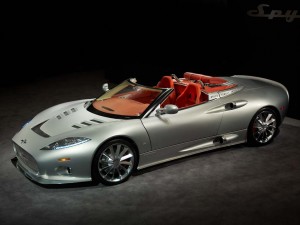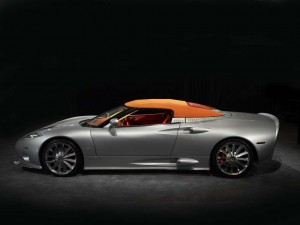
With the addition of the new Aileron Spyder, the Dutch supercar maker, Spyker, hopes to gain real traction in the market.
Among the nations likely to turn out a new supercar, one has to admit The Netherlands isn’t at the top of the list. Mention Holland and you’re more likely to think of tulips, wooden shoes, a little Dutch boy or maybe the hash houses of Amsterdam. But if Victor Muller has his way, you’re going to have to revise your thinking.
Muller’s small development team has already delivered some surprises since his start-up automaker was launched, nearly a decade ago. The original Spyker Spyder was a high-priced, super sports car with the manners of a go-kart and the performance of a muscle car.
With the launch of the more sophisticated Aileron Coupe, Spyker aimed to firmly establish itself as a serious alternative to the likes of Ferrari and other, better-established supercar manufacturers. Now comes the Spyder, a $235,000 open-top version of the two-seater.

The Spyker Aileron Spyder features a fully functioning convertible top, unlike the awkward canvas top of the smaller Spyker Spyder.
Like many hopeful sports car makers, Spyker staged the debut of the convertible on the hill above the Lodge at Pebble Beach, the site of one of the world’s most tony classic car shows, the annual Concours d’Elegance.
Out front of the company’s tent, a very different sort of Spyker was on display, a 1903 runabout that was one of the first automobiles built by the Dutch Spyker family. They originally started out as coachbuilders, and one of their horse-drawn carriages is still used, each year, to bring the queen to parliament for its opening session. In 1914, Spyker added aircraft, a source of the propeller and turbine imagery – and the names — used in products like Aileron.
In fact, the original Spyker went broke in 1925, the family abandoning the corporate name until Muller, a highly-motivated lawyer, entrepreneur and avid car collector, came along, 74 years later.
“If I knew then what I know now,” he acknowledged during a conversation with TheDetroitBureau.com, “I’d have probably shot myself. But I wanted to make it a real company.”
Muller targeted his new company to appeal to the rare breed of sports car aficionados and car collectors who were more intrigued by craftsmanship, design and performance than the actual nameplate bolted to the sheet metal. He was hoping to get by producing no more than 10 cars a year. As it’s turned out, Spyker is now producing closer to 100 and hopes to bump that up several-fold with the Aileron Spyder.
Like the Aileron Coupe and the company’s original convertible, the Spyder’s chassis was developed in cooperation with the British Lotus Engineering. The vehicle’s over-the-top design was an in-house effort, however, with Muller claiming his role as chief stylist.
Longer than the original Spyder, the Aileron convertible retains the gullwing door design, the rear-engine configuration and the quad set of air scoops just behind the doors – two for the engine, the others to cool the rear brakes.
The newer car is decidedly more refined in appearance, particularly in the cabin. The original Spyder had a decidedly go-kart quality, with minimalistic gauges and switches. The Aileron, both Coupe and Spyder, is more elegantly refined, with backlit instrumentation, but a similar sort of aviation-style toggle switches.
The heart of all Spyker products is a 4.2-liter naturally-aspirated V-8 provided by Audi, which makes 400 horsepower and 358 pound-feet of torque. That’s plenty of muscle for a car that weighs in at just over 3100 pounds. The original Spyder featured a 6-speed manual gearbox. With the new Aileron convertible, Spyker switches to a 6-speed automatic and is considering offering a double-clutch manual, the latest trend in sports car technology.
Over the course of an afternoon, we had a chance to drive a variety of Spyker products through some of the less populated portions of Pebble Beach.
The original convertible, with its short wheelbase, was blindingly quick at launch – Syker claiming a 0 to 60 time of just over 4 seconds — though the car had a tendency to buck, like a go-kart, over even modest road bumps. Steering was almost intuitively responsive, requiring just the most minor flick of the wrist to weave through the Del Monte Forest.
The downside was the racing-derived brake system, which required a surprising amount of effort to bring the car to a stop. It took time to get comfortable with the system, though as we did, we realized the Spyder could be brought to a halt as fast as just about any car on the road. The car features ABS and Traction Control, by the way, but no stability control technology.
The same is true for the longer Aileron. The added wheelbase helped enhance the car’s stability on the old roads of Pebble Beach. And the upgraded suspension was more forgiving – without yielding any of the tremendous compliance of the smaller Spyder. Steering was equally nimble, but a different brake system seemed much easier to use, especially for the average driver.
If the Aileron Spyder meets Muller’s expectations, sales should more than double and, within the next two years, Spyker should be “cash-flow positive,” something the now publicly-traded company clearly needs.
How much more growth is possible? The company’s goals are clearly ambitious. Spyker’s Latin motto translates into, “For the tenacious, no road is impassible.” According to marketing director Hans van Rennes, the little automaker plans to introduce two new models or variants a year, going forward. Next up is the SSUV, or Super Sport-Utility Vehicle, which should debut at next year’s Geneva Motor Show.
The SSUV, said van Rennes, will be a “true 4-seater.” It will mark a shift away from the long-running Spyker partnership with Audi, though the executive won’t yet say which Italian automaker will provide the ute with its 567-horsepower engine and mate it to a double-clutch manual gearbox. The SSUV is expected to weigh in at around 4250 pounds, or 1000 less than the Porsche Cayenne Spyker appears to be using as a benchmark.
After a decade, Muller admits it is still an uphill battle making Spyker a real player in the costly and competitive car business. “People wonder why they should spend on a car made by a company that won’t be around in a year,” says the entrepreneur. Spyker’s recent success at the 24 Hours of Le Mans has helped give it credibility – it finished behind Ferrari in the GT2 category, but ahead of Porsche. Now comes the new Aileron Spyder.
Spyker doesn’t want a big piece of the automotive pie – but just a little bump in sales, the Dutch company bets, will plug the hole in its financial dike and finally make it a viable alternative in the rarified supercar market.
